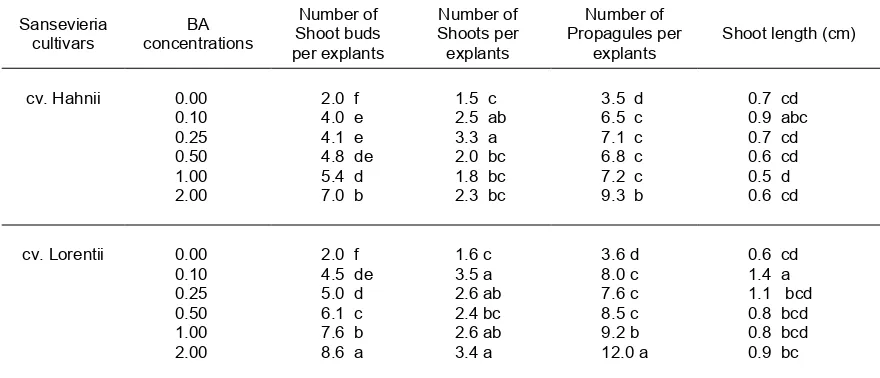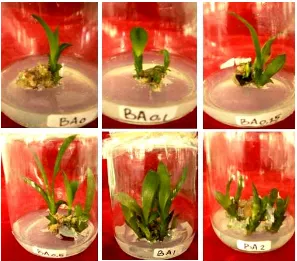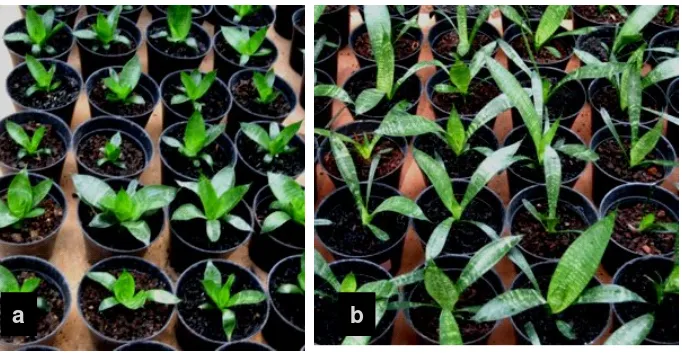IN VITRO
ORGANOGENESIS OF TWO
SANSEVIERIA
CULTIVARS
ON DIFFERENT CONCENTRATIONS OF BENZYLADENINE (BA)
Yusnita*), Wiry Pungkastiani2) and Dwi Hapsoro3)
Plant Science Laboratory, Department of Agronomy, College of Agriculture, The University of Lampung. Jl. Sumantri Brojonegoro no. 1 Bandar Lampung 35145
*) Corresponding author Phone: +62-8128145990 E-mail: yusnita.said@yahoo.com
Received: June 23, 2010/ Accepted: March 2, 2011
ABSTRACT
In vitro regeneration of buds and shoots via organogenesis in two genotypes of Sansevieria trifasciata was established. Leaf segments (1cm x 1cm) of cv. Hahnii and cv. Lorentii were cultured on Murashige and Skoog (MS) basal medium containing 2.4-dichloro-phenoxyacetic acid (2.4-D) for 1 week, trans-ferred into MS medium without plant growth regulator (MS0) for 1 week, and then cultured to MS medium containing different concentrations of benzyladenine (BA:0; 0.1; 0.25; 0.5; 1 and 2 mg/l) for 3 consecutive passages with 4 week intervals. The results showed that BA proved to be an effective cytokinin to induce the formation of adventitious buds and shoots in two cultivars of Sansevieria trifasciata. The maximum of 12 propagules per explant of Lorentii and 9.3 propagules of Hahnii were obtained in medium with 2 mg/l BA after 14 weeks. Furthermore, regenerative capacity to form shoot buds and propagules was genotype dependent. The popagules number formed by cv. Lorentii was significantly higher than those formed by cv. Hahnii. The average shoot length formed by cv. Lorentii was also higher than those of cv. Hahnii. Shoots of both cultivars were successfully ex vitro rooted and acclimatized to the greenhouse with high survival rate (95.9 -100%).
Keywords: organogenesis, Sansevieria trifas-ciata, benzyladenine, genotypes
INTRODUCTION
Sansevieria (Sansevieria trifasciata) or snake plant is a genus of ornamental foliage suitable for either outdoor or indoor plants. Plants from this genus are widely used for their beautiful and various shapes, colors, and
patterns of their leaves. The color of its leaves varies from dark green, pale green, grayish green or a combination of green and white or yellow with a various snake skin pattern of the lamina. In addition to ornamental foliage, sansevieria is used as a plant that absorbs hazardous pollutant from the atmosphere. A research conducted by NASA found that snake plants were capable of absorbing carbon monoxide and lead from atmosphere. In Japan, it was reported that sansevieria could absorb many hazardous gases from atmospheres such as chloroform, formaldehyde, trichloroethylene, benzene and xylene in a significant amount (Suara Pembaharuan, 2005). People in Thailand believe that snake plants could be used as traditional medicinal plants for several diseases such as diabetes and cancer. Korean people believe that this genus can be used to overcome effect of various radiation, and some people of China think that planting sansevieria brings some good luck.
Since the year 2000, demand of sansevie-ria in Indonesia has dramatically increased and reached the highest in 2004, and remains high up to now. The cultivars of sansevieria mostly needed are cv. Lorentii or sword type and cv. Hahnii or the short type. Some of the local markets of sansevieria increase significantly due to the high demand for export. During the last five years, demand of sansevieria, especially from Korea and Japan, has been considerably high. For instance, since April 2005, 3500 plants of cv.Hahnii had been delivered for Malaysian buyers and one container of sansevieria was ordered by each of the buyers from Korea, Japan and Europe (Kontan, 2005).
sansevieria could not fulfill the demand yet due to slow growing manner of plant propagation. Sansevieria is conventionally propagated by suckers and leaf cuttings. Both methods need plenty amount of plant materials and a long period of time to produce significant number of propagules. Generally, only 1-3 propagules are obtained from 1 leaf cutting for 2 months, and until 5 months the number of propagules remains constant without proliferarion. Plant tissue culture could be an alternative to the conventional methods to produce a large number of propagules in a relatively short time. One pattern of in vitro regeneration of sansevieria is via organogenesis.
Blazich and Novitzky (1984) previously reported in vitro organogenesis of Sansevieria tifasciata using leaf segments as explants. In their report, explants were cultured on Murashige and Skoog (MS) (1962) medium supplemented with 0.25 mg/l 2,4-dichlorophenoxy acetic acid (2,4-D) for 2 weeks followed by cultures for 2 more weeks on MS without growth regulator (MS0) to induce callus formation. To induce adventitious shoot formation, explants were then transferred to MS + 0.3 mg/l kinetin. Wahyuningsih (2006) found that when 1x1 cm2 leaf segments of Sansevieria trifasciata var. Lorentii were cultured on callus induction medium, followed by explant transfer to MS medium containing benzyladenine or kinetin, formation of adventitious shoots was observed. Responses of different cultivars to a certain growth regulator could be different as reported by Veltcheva and Svetleva (2005) in in vitro organogenesis of Phaseolus vulgaris L. This research was aimed to study the formation of adventitious shoots of two varieties of Sansevieria trifasciata (cv. Hahnii and cv. Lorentii) as affected by different concentrations of benzyladenine (BA).
MATERIALS AND METHODS
Plant Materials and Explant Preparation This research was conducted in Plant Tissue Culture Laboratory, Department of Agro-nomy, College of Agriculture, The University of Lampung from March to August 2006. The plant materials were obtained from the local market in Lampung. The source plants of Sansevieria trifasciata cv. Hahnii and cv. Lorentii were maintained at green house with routine culture
procedures including watering, cleaning of the leaves and spraying with pesticide. Explants were taken from fully expanded young leaves cut at ¾ of the upper part for Hahnii and ½ of the upper part for Lorentii. Explant surface-sterilization was started by washing the leaf cuttings using detergent under tap water for approximately 20 minutes. After that, leaf segments of 3 cm in size were rinsed in 5% of commercial bleach solution for 15 minutes followed by rinsing with tap water. The second sterilization was done in laminar air flow cabinet (LAFC, Bassaire, Hampshire, England). The leaf segments were soaked in 10% of Bayclin commercial bleach (Johnson, Jakarta, Indonesia, 5.25% NaOCl) solution for 15 minutes followed by three-time rinsing with sterile aquadest. One leaf blade of sansevieria cv. Hahnii was cut into ± 20 explants, whereas that of cv. Lorentii was cut into 40-50 explants.
All disecting tools, ie., Petri dishes (Iwaki, Asahi Glass Co. Ltd. Thailand), forceps, scalpels (Maiden Stainless, Japan), bottles (Jakarta, Indonesia) and aquadest were sterilized by autoclaving (Tommy®, Tokyo, Japan) at 1210C Darmstadt, Germany) for one week, followed by transferring to MS medium defoid of growth regulators (MS0). After being incubated for one week in MS0, all explants were transferred to shoot-inducing medium with different con-centrations of benzyladenine (BA) (Merck KgaA, Darmstadt, Germany). Subcultures to the fresh media with the same treatments were conducted twice in 4 weeks intervals. All cultures were incubated in a culture room at 26±20C provided by cool-white fluorescent light (Phillip, Indonesia) at 2000 lux continuously.
Organogenesis of Two Sansevieria Trivasciata Cultivars on Different Concentrations of BA
explants. Number of shoot buds (meristemoid structures < 0.5 cm), shoots ( ≥ 0.5 cm in length) and propagules (i.e., buds + shoots) and length of shoots were recorded after 14 weeks; in some treatments, it was after 18 weeks of cultures. In addition, cultures of sansevieria cv Lorentii with BA 0.5, 1.0 and 2.0 mg/l were subcultured three times, and the number of shoot buds and shoots were counted after 18 weeks. To measure all observed parameter, the plants were removed aseptically to a sterile Petri dish with millimeter block placed under the dish. Data was subjected to analysis of variance (ANOVA) using Minitab Statistical Software version 13.20. If there was any significant results of ANOVA, Least Signi-ficant Difference (LSD) method (Lentner and Bishop, 1986) at P≤ 0.05 was used to detect differences among treatments.
The basal medium formulation used for callus, meristemoid and shoot induction was macro and micro salts of Murashige and Skoog (1962) medium supplemented with 30 g/l sucrose, 0.1 mg/l thiamine–HCl, 0.5 mg/l nico-tinic acid, 0.5 mg/l pyridoxine-HCl, 2 mg/l glycine and 100 mg/l myo-inositol (Merck KgaA, Darmstadt, Germany). The pH of medium was adjusted to 5.8 with 1N KOH or 1N HCl prior to addition of 7 g/l agar powder. The mixture was then boiled to make the agar soluble and a 30 ml-aliquots of medium were dispensed to 250 ml- culture bottles before autoclaving at 1210C and 1.5 kg/cm2 for 20 min.
Ex vitro rooting of shoots (4-5 cm in length) was done by treating the base of the shoots with 0.2% (w/w) indolebutyric acid (IBA) (Merck KgaA, Darmstadt, Germany) and planting them in a 10 cm pot in diameter containing (1:1) mixture of sand and compost, then placed on benches in a shaded greenhouse. Irrigation with tap water was given once a day. After two months, survival of acclimatized plantlets was recorded.
RESULTS AND DISCUSSION
Results of this experiment showed that in vitro indirect organogenesis of two varieties of Sansevieria trifasciata can be done successfully from leaf segments as explants. Organogenesis
of Sansevieria trifasciata leaf explants was initiated by the formation of callus at the cutting edge of explants. All explants from the two cultivars tested swelled, and formed callus and greenish meristemoid during the first two weeks of cultures, and when explants were transferred to shoot-inducing medium containing various concentrations of BA, shoot bud and shoot initiation occured.
In general, both BA concentrations and sansevieria genotypes affected organogenesis capacity of the explants tested. However, there was no interaction between BA concentrations and cultivars which affected variables recorded. The highest number of shoot buds and propagules in both cultivars was formed at medium with 2 mg/l BA. In addition, Sansevieria trifasciata cv. Lorentii showed higher organogenic capacity than that of cv. Hahnii (Table 1). The culture appearance of Sanse-vieria trifasciatacv. Hahnii is presented in Figure 1, while that of cv. Lorentii is in Figure 2. Those figures showed that regenerated shoots of cv. Hahnii were shorter than those of cv. Lorentii.
Table 1. Effects of cultivars and benzyladenine (BA) concentrations on number of shoot buds, number of shoots, number of propagules per explant and shoot length of two sansevieria cultivars after 14 weeks of cultures
Significancy based on ANOVA (analysis of variance)
ns = non- difference among treatment based on LSD at P≤ 0.05.
\\
Figure 2. Appearance of cultures of Sansevieria cv. Lorentii on MS medium with various concentrations of BA after 14 weeks.
In this experiment, callus and meristemoid induction occured when explants were cultured on MS medium supplemented with 0.25 mg/l 2.4-D for 1 week followed by transferring to MS medium without growth regulator (MS0) for 1 week. In previous reports (Blazich and Novitsky, 1984; Wahyuningsih, 2006), callus and meristemoid induction was done by culturing explants on MS+2.4-D for 2 weeks, followed by transferring to MS0 for 2 weeks, so merestemoid formation required 4 weeks.
Results of this experiment also revealed that genotypes significantly affected regeneration capacity of explant to form shoot buds or shoots. Sansevieria trifasciata cv. Lorentii showed higher organogenic capacity than cv. Hahnii, which was indicated by the higher number of shoot buds (8.6).The propagules (12.0) obtained in cv. Lorentii compared to those of cv. Hahnii (7.0 and 9.3, repectively). The mean length of regenerated shoots of cv. Lorentii was also higher than that of cv. Hahnii. The optimum concentration of cytokinin which resulted in the best multiplication rate of any micropropagation
different species or genotypes was due to different endogenous phytohormones as well as different activities of several enzymes related to auxin and cytokinin metabolism, which in turn shifted the auxin and cytokinin pool.
Shoots of both cultivars were successfully ex vitro rooted and acclimatized in the green house with 95.9-100% survival rate. Figure 3 shows the acclimatized plantlets of Sansevieria trifasciata cv. Hahnii (a) and cv. Lorentii (b) after 2 months in the green house.
The propagation efficiency of the two cultivars of Sansevieria trifasciata by this micropropagation method was much higher than conventional propagation by leaf cuttings. Using leaf cuttings, we can get maximum of 2 leaf cuttings per blade of cv. Hahnii and maximum of 5 leaf cuttings per leaf blade of cv. Lorentii. In two months, if 2-3 plants are regenerated from each cutting, a maximum of 6 plants of cv. Hahnii and 15 plants of cv. Lorentii can be obtained, and since the shoots obtained by leaf cutting would not proliferate, the number of plants would not change until four or five months. Using this micropropagation method, we can get an average of 20 explants per leaf
blade from cv. Hahnii and 40 explants per leaf blade from cv. Lorentii. Considering an average 80 % success of sterilization and subculturing, we can obtain an average of 16 aseptic cultures of cv. Hahnii and 32 aseptic cultures of cv. Lorentii per leaf blade. Based on the data obtained in this experiment, after 4.5 months (18 weeks) we can get potentially 32 x 11 = 352 shoots of cv. Lorentii per leaf, provided that after the third subcultures (at 18 months) 11.1 shoots are obtained from cultures with 2 mg/l BA. The figures of cv Hahnii, on the other hand, based on the data available (from 14 weeks of cultures), we can get potentially 16 x 3 shoots = 48 shoots per leaf blade in 14 weeks (3.5 months). If one more subculture was conducted, we might expect at least doubled shoots per explant, and the figures with Hahnii might become 96 shoots obtained per leaf. With 95% survival rate of acclimatization, 91 plants of cv Hahnii and 334 plants of Lorentii would be obtained per leaf blade. Compared to propagation by leaf cuttings, micropropagation would potentially be about 15 times as efficient as leaf cuttings for sansevieria cv Hahnii, and about 22 times as efficient as leaf cuttings for cv. Lorentii.
a
b
CONCLUSSIONS
Successful in vitro organogenesis of Sansevieria trifasciata var. Hahnii and Lorentii was performed. Results showed that both BA concentrations and Sansevieria cultivars affected organogenesis capacity of the explants. However, there was no interaction between BA con-centrations and cultivars which affected variables recorded.
The highest number of shoot buds and propagules in both cultivars was formed at medium with 2 mg/l BA.Sansevieria trifasciatacv. Lorentii showed higher regeneration capacity than that of cv. Hahnii. Shoots of both cultivars were successfully ex vitro rooted and acclimatized in the green house with 95.9 % - 100% survival rate. Compared to propagation by leaf cuttings, this micropropagation method would be approximately 15 times as efficient as that for sansevieria cv Hahnii, and about 22 times as efficient as that for cv. Lorentii.
ACKNOWLEDGEMENTS
The authors would like to thank to Dr. Karyanto and others reviewers chosen by the editorial boards for reviewing this manuscript and Triani Wahyuningsih for her technical help.
REFERENCES
Ali, A., S. Naz, F.A. Siddiqui and J. Iqbal. 2008. An efficient protocol for large scale production of sugarcane through micropropagation. Pak. J. Bot. 40 (1): 139-149.
Anis, M. and A. Shahzad. 2005. Micropro-pagation of Sansevieria cylindrica Bojer Ex Hook through leaf disc culture. Prop. Ornament. Plants 5 (3): 119-123.
Blazich, A.F. and R.T. Novitzky. 1984. In vitro propagation of Sansevieria trifasciata cv Lorentii. HortSci. 19(1): 122—123. Budiarto, K. 2010. Spectra Quality Effects
Morphogenesis on Anthurium Planlet During in Vitro Culture. Agrivita 32 (3) : 234-239.
Gandonou, C., T. Errabii, J. Abrini, M. Idaomar, F. Chibi and N.S. Senhaji. 2005. Effects of genotype on callus induction and plant regeneration from leaf explants of sugarcane (Saccharum sp.). Afric. J. Biotech. 4(11):1250-1255.
Hirimburegama, K. and N. Gamage. 1997. Culti-var specificity with respect to in vitro micropropagation of Musa spp. (banana and plantain). 1997. J. Hort. Sci. 72(2): 205-211.
Hodson de Jaramillo, E., A. Forero, G. Cancino, A.M. Moreno, L.E. Monsalve and W. Acero. 2008. In vitro regeneration of three chrysanthemum (Dendranthema gran-diflora) varieties ‘via’ organogenesis and somatic embryogenesis. Univ. Sci. 13(2): 118-127.
Lentner, M. and T. Bishop. 1986. Experimental design and analysis. Valley Book Company. Blacksburg, VA-USA. 565 pp. Murashige, T. and F. Skoog. 1962. A revised
medium for rapid growth and bioassays with tobacco tissue cultures. Physiol. Plant. 15:473-497.
Shahzad, A., N. Ahmad, M.A. Rather, M.K. Husain and M. Anis. 2009. Improved shoot regeneration system through leaf derived callus and nodule culture of sansevieria cylindrica. Biol. Plant. 53(4):745-749. Sriskandarajah, S., E. Prinsen, V. Motyka, P.I.
Dobrev and M. Serek. 2006. Regenerative capacity of cacti Schlumbergera and Rhipsalidopsis in relation to endogenous phytohormones, cytokinin oxidases/dehy-drogenase, and peroxidase activities. J. Plant Growth Regul. 25: 79-88.
Suara Pembaharuan. 2005. Daun-daun yang naik daun. Suara Pembaharuan, 8 Sep-tember. Jakarta.
Veltcheva, M. R. and D.L. Svetleva. 2005. In vitro regeneration of Phaseolus vulgaris L. via organogenesis from petiole ex-plants. J. Central European Agric. 6(1):53-58. Wahyuningsih, T. 2006. Pengaruh beberapa
konsentrasi benziladenin (BA) atau kinetin pada pembentukan tunas adventif Sansevieria trifasciata Lorentii in vitro. Skripsi Fakultas Pertanian, Universitas Lampung. pp.26.


